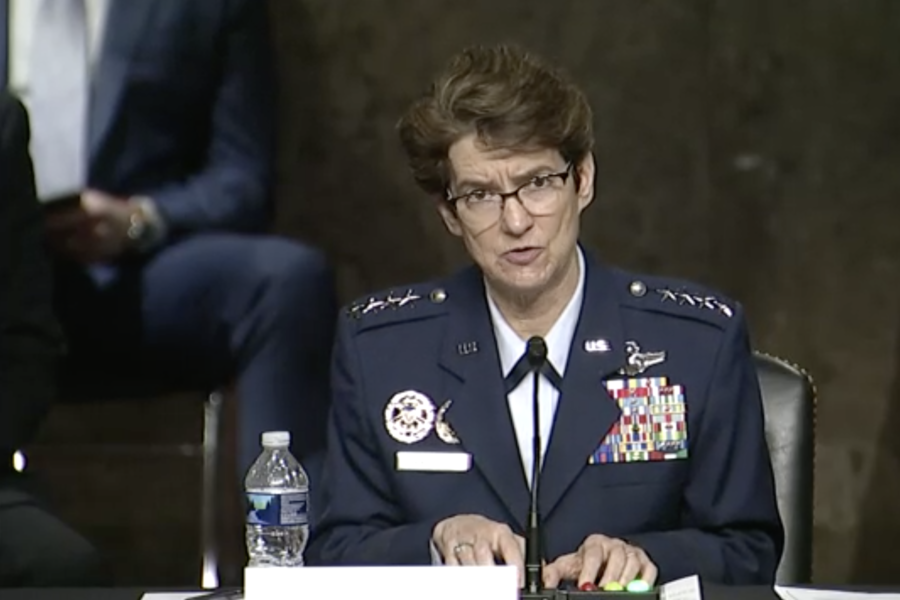The Air Force has managed to address its gap in aerial refueling capability thanks to the KC-46 tanker being cleared for limited operations and the Air Force Reserve and Air National Guard stepping up to take on a bigger workload, Air Mobility Command boss Gen. Jacqueline D. Van Ovost said at her confirmation hearing to become the new head of U.S. Transportation Command.
Van Ovost’s confirmation hearing in front of the Senate Armed Services Committee on Sept. 23 appeared to go well, with none of the senators present raising any objections to her nomination, keeping her path to confirmation seemingly smooth. They did, however, pepper her with questions on China, cybersecurity, military family moves—and the state of the Air Force’s aerial refueling fleet.
Particularly, Sen. Angus King (I-Maine) asked Van Ovost about comments made by the man she would replace as the head of TRANSCOM, Army Gen. Stephen R. Lyons—in early 2020, Lyons warned that the Air Force’s plans to retire aging KC-135s and KC-10s before the KC-46 was cleared for operations would create “a capacity gap with significant impacts to combatant command daily competition and wartime missions.”
“A few years ago, that’s exactly where we were headed,” Van Ovost acknowledged. “But since then, now that we have brought the KC-46 interim capability release to bear for U.S. TRANSCOM taskings, and in addition, we have amazing support from our Total Force volunteerism to increase taskings of the Guard and Reserve refueling assets, we have been able to meet and I foresee that will be absolutely able to meet the day-to-day requirements and any wartime requirements made.”
There have been two interim capability releases for the KC-46 thus far. In July, Air Mobility Command cleared the troubled tanker to use its centerline drogue for refueling operations. In August, it was cleared to refuel C-17s, B-52s, and other KC-46s in certain circumstances.
The tanker is still not allowed to deploy for combat operations, as the Air Force and Boeing work to fix a host of deficiencies, chief among them the Remote Vision System and a “stiff” refueling boom. It did, however, help with the recent airlift of thousands of Americans and Afghan refugees, Van Ovost confirmed.
Van Ovost also seemed to hint at a new interim capability release coming, saying, “I expect we’re going to be refueling F-16s and F-15s in the very near future.” The timeline for putting Remote Vision System 2.0 into planes, she confirmed, remains 2024.
Family Moves
Beyond the aerial refueling fleet, Van Ovost fielded several questions from senators concerned about military families moving.
TRANSCOM issued what it called the Global Household Goods contract to a single company in June 2020 to assist military families with packing, moving, and unloading when PCS’ing, but that contract was protested and overturned. A new award is expected in October, but in the meantime, thousands of families have had to move, and TRANSCOM has had to coordinate with hundreds of different companies.
“Frankly, what we learned in COVID was it really exacerbated the flaws that are in the current contract,” Van Ovost said, calling it a quality-of-life issue. “And having a single move manager with a multiyear contract, they’d be more confident to invest in quality suppliers and digital IT and will be pressed with the accountability that our family members deserve.”
China
After Air Force leaders spent much of this past week emphasizing competition with China at AFA’s Air, Space & Cyber Conference, Van Ovost did much of the same in her hearing. She agreed with Sen. Josh Hawley (R-Mo.) that China is the Defense Department’s pacing threat, and she told Sen. Tom Cotton (R-Ark.) that the Chinese have tried to impose authoritarianism beyond their borders by coercing U.S. partners and allies.
In the context of TRANSCOM, Van Ovost said, these actions underline the importance of logistics.
“Facing these threats from China and Russia and strategic competition, we have learned that we really need to ensure that logistics planning is integrated with all joint warfighting functions,” Van Ovost said. “Logistics planning is not an add-on, and it needs to be part of the deliberative process as we go forward. So if confirmed, I’ll work with the other combatant commanders to ensure that logistics concerns are being addressed early and we provide options to them for the best use of the scarce resources.”
If confirmed, Van Ovost would become the third woman to ever lead a combatant command. In August, the Senate confirmed Army Lt. Gen. Laura J. Richardson, then-commander of United States Army North, to receive her fourth star and to lead U.S. Southern Command. Richardson will be the second woman to lead a combatant command, following retired Air Force Gen. Lori J. Robinson, who commanded NORTHCOM before retiring in 2018.
